2023 Reports 1 to 5 of the Commissioner of the Environment and Sustainable Development to the Parliament of Canada
Report 1—Forests and Climate Change
At a Glance
Given early tree planting results and issues with establishing partnerships, it is unlikely that the 2 Billion Trees Program will meet its objectives unless significant changes are made. While the department nearly met its goal to plant 30 million trees in 2021, the first year of the program, it fell well short of its second-year goal. In the best-case scenario, after 2 years, the program would reach only 2.3% of the overall 2 billion tree goal in 2022.
Natural Resources Canada did not have long-term project agreements in place with provinces and territories, which will be necessary to meet the program’s 3 main objectives—to capture carbon, enhance biodiversity, and support human well‑being. The department had also not determined how it would monitor planted trees over the long term, which means that it will not know whether these trees have survived or whether they are benefitting Canadians as intended. This is concerning, because planting trees is part of Canada’s plan to tackle the twin crises of climate change and biodiversity loss.
Beyond the 2 Billion Trees Program, Natural Resources Canada and Environment and Climate Change Canada did not provide a clear and complete picture of the effects of Canada’s greenhouse gas emissions from forests. For example, published reports did not provide sufficient information on how logging or changes in forest management affected Canada’s emissions. Reporting on forests’ contribution to Canada’s emission reduction target was also inconsistent, as it was included in some reporting but not in all. This makes it difficult for decision makers to use the information to guide policy decisions and for Canadians to hold government to account.
There is no solution to climate change and terrestrial biodiversity loss that does not include forests. Given the current climate and biodiversity crises, the federal government must successfully implement solutions, such as the 2 Billion Trees Program, and communicate the full picture of how Canadian forests affect carbon levels in our atmosphere.
Why we did this audit
- Because there is no solution to climate change and terrestrial biodiversity loss that does not involve forests, parliamentarians and Canadians need a clear picture—backed by rigorous measurement and reporting—of the forest sector’s effects on climate change and of the effects of the federal investments in nature‑based solutions involving forests.
- Accurate and consistent information on forest-related greenhouse gas emissions can support the development of policies, allow stakeholders and decision makers to assess progress, and determine whether any adjustments or further actions are needed.
Key findings
- Given the early tree planting results, it is unlikely that the 2 Billion Trees Program will meet its objectives unless significant changes are made.
- The 2 Billion Trees Program is not expected to achieve its originally anticipated emission reductions, even if fully implemented, and biodiversity benefits could be better realized.
- The effects of Canada’s forests on emissions have not been effectively communicated to support decision making and accountability toward meeting climate targets.
Key facts and figures
- Canada has nearly 362 million hectares of forests, making it the third most‑forested country in the world.
- Canada’s forests are becoming a net source of emissions because of forest fires and disturbances caused by insect outbreaks. In some recent years, these natural disturbances have released over 200 megatonnes of carbon dioxide equivalent per year into the atmosphere: for example, in 2018, emissions from these disturbances would have added 26% to the national total, if they had been included in reporting.
- Natural Resources Canada and Environment and Climate Change Canada did not clearly report on the effects of human activities on forest emissions.
Highlights of our recommendations
- To ensure that it can meet the planting objectives of the 2 Billion Trees Program, Natural Resources Canada should
- Clearly document how the program will be operationalized to meet its planting goals and its 2031 and 2050 targets for reducing greenhouse gas emissions
- Promptly develop specific measures to address the lack of long-term agreements with project partners
- To inform policy decisions that support emission reductions and improve transparency, Environment and Climate Change Canada, working with Natural Resources Canada, should, in its reports on historical and projected emissions,
- state the greenhouse gas effects of changes in forest management
- work with provinces and territories to report data by province and territory, so that the effects of forest management practices are more evident
- present information in ways that the public can readily access and easily understand
Please see the full report to read our complete findings, analysis, recommendations and the audited organizations’ responses.
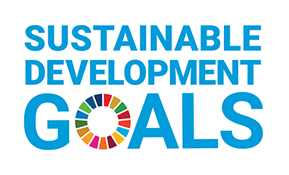

The United Nations’ Sustainable Development Goal 13 (Climate Action) commits to taking urgent action to combat climate change and its impacts.
We found that Environment and Climate Change Canada did not include forests in other key greenhouse gas indicators—such as indicators under the Sustainable Development Goals and the Federal Sustainable Development Strategy—even though those frameworks have the same 2030 target. Calculating greenhouse gas indicators differently or excluding different components create inconsistencies that can hinder the monitoring and reporting of progress and the identification of needed adjustments.
Visit our Sustainable Development page to learn more about sustainable development and the Office of the Auditor General of CanadaOAG.
Exhibit highlights
Natural Resources Canada was behind on its estimated annual planting
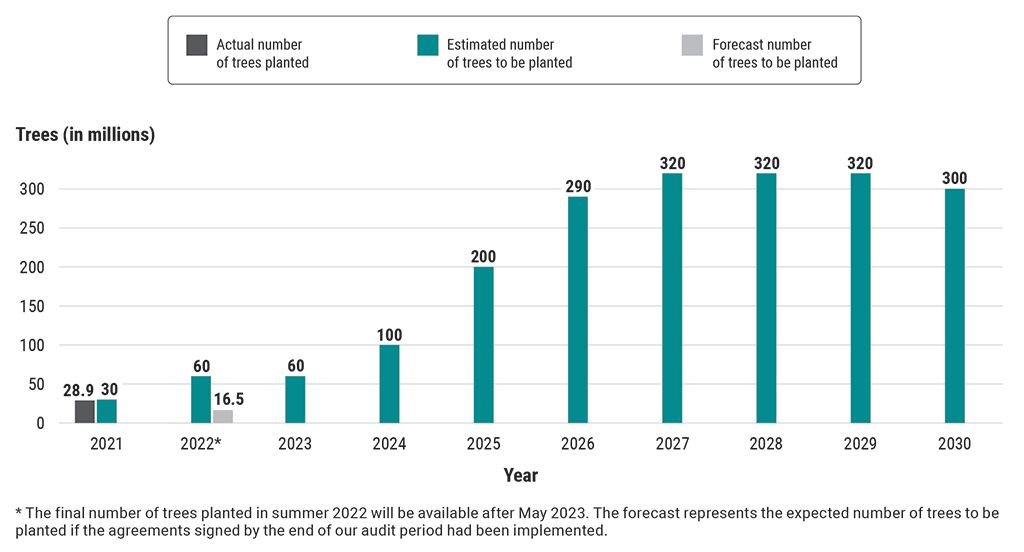
Source: Adapted from Natural Resources Canada
Text version
This bar chart shows the actual number of trees planted in 2021, the forecast number of trees to be planted in 2022, and the estimated number of trees to be planted from 2021 to 2030. The final number of trees planted in summer 2022 will be available after May 2023. The forecast represents the expected number of trees to be planted if the agreements signed by the end of our audit period had been implemented. The estimated number of trees to be planted increases significantly from 2023 to 2027, remains steady through to 2029, and drops slightly in 2030.
In 2021, the actual number of trees planted was 28.9 million, and the estimated number of trees to be planted was 30 million.
In 2022, the estimated number of trees to be planted was 60 million, and the forecast number of trees to be planted was 16.5 million.
In 2023, the estimated number of trees to be planted is 60 million.
In 2024, the estimated number of trees to be planted is 100 million.
In 2025, the estimated number of trees to be planted is 200 million.
In 2026, the estimated number of trees to be planted is 290 million.
In 2027, 2028, and 2029, the estimated number of trees to be planted is 320 million.
In 2030, the estimated number of trees to be planted is 300 million.
Environment and Climate Change Canada’s reports on emissions did not include forest fires or insect disturbances in national totals
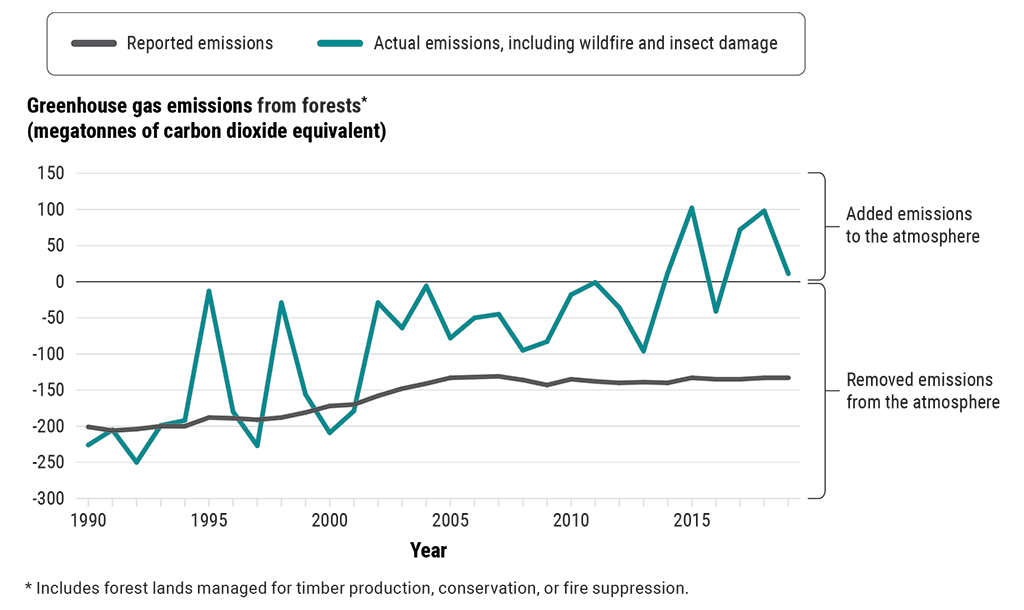
Source: Adapted from Natural Resources Canada
Text version
This chart compares reported greenhouse gas emissions from forests with actual greenhouse gas emissions from forests, including wildfire and insect damage, from 1990 to 2019. When emissions from wildfire and insect damage are included in total emissions from forest lands, there are large fluctuations in emissions. The emissions from forests include forest lands managed for timber production, conservation, or fire suppression. According to the reported numbers, forests removed emissions from the atmosphere for the whole period of time, while the actual numbers show that forests added emissions to the atmosphere in most years from 2014 to 2019.
According to reported emissions, in 1990, forests removed about 201 megatonnes of carbon dioxide equivalent from the atmosphere. Then, forests’ removal of emissions declined gradually to about 133 megatonnes in 2005, then remained between 131 and 143 megatonnes until 2019.
The actual emissions, including wildfire and insect damage, showed large fluctuations in emissions. In 1990, according to actual emissions, forests removed about 226 megatonnes of carbon dioxide equivalent from the atmosphere. Forests removed 250 megatonnes in 1992, then 13 megatonnes in 1995. They removed 227 megatonnes in 1997, 29 megatonnes in 1998, 209 megatonnes in 2000, 29 megatonnes in 2002, 64 megatonnes in 2003, 6 megatonnes in 2004, 78 megatonnes in 2005, 95 megatonnes in 2008, 1 megatonne in 2011, and 41 megatonnes in 2016.
According to actual emissions, in 2014, forests added 12 megatonnes of emissions to the atmosphere. They added 102 megatonnes in 2015, 98 megatonnes in 2018, and 11 megatonnes in 2019. These numbers contrast with the reported emissions, which show that forests removed emissions from the atmosphere instead of adding emissions to the atmosphere.
Slash burning is a forest management activity that was not separately reported in federal reports
In some circumstances, prescribed or controlled fires can be a valuable tool to reduce wildfire risk, enhance wildlife habitat, conduct site preparation, or use for Indigenous cultural purposes. However, burning of post‑harvest residuals (slash burning) can create significant greenhouse gas emissions. For example, in British Columbia in 2020, slash pile burning, which is one component of slash burning, represented 4% of the overall greenhouse gas emitted annually.
We found that federal reports did not clearly distinguish the emissions associated with slash burning from other forms of controlled burning. In our view, separately communicating emissions related to slash burning at the federal level could better inform related forest-sector policy decisions, including investigating alternative uses for post-harvest residues.
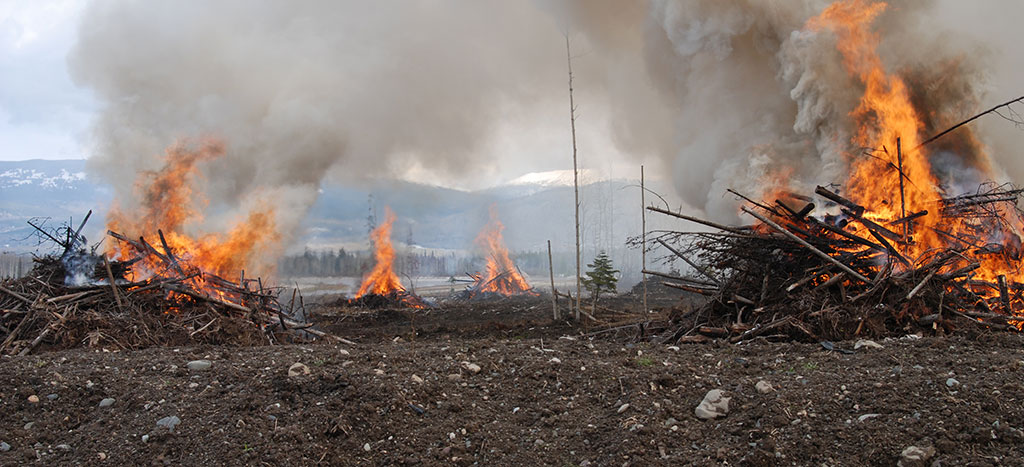
Photo: Ben Weinstein
Estimates of emissions from forest land use in national inventory reports varied significantly from report to report
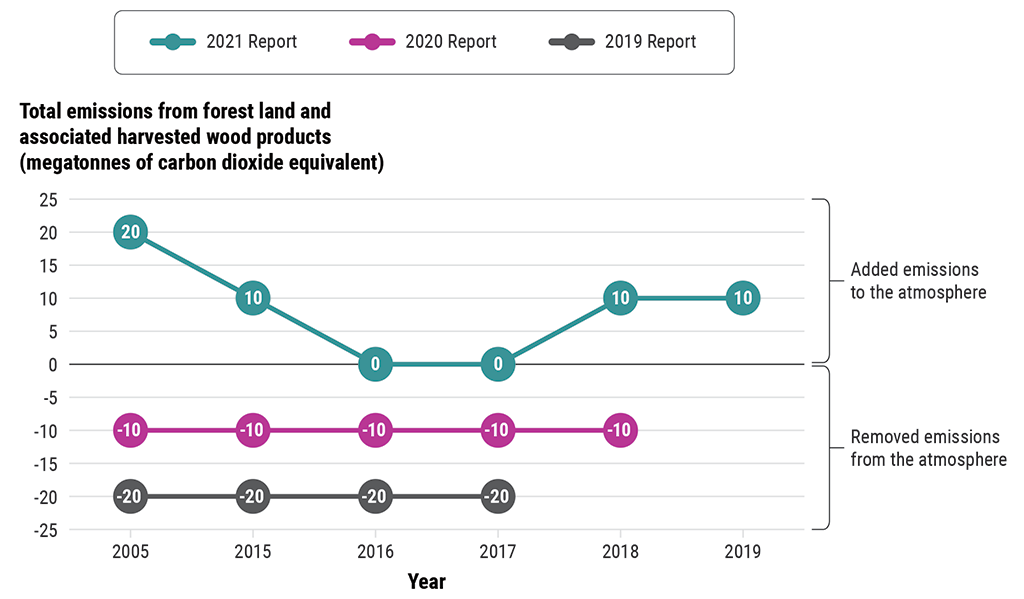
Source: Based on data from Environment and Climate Change Canada
Text version
This chart shows the estimates of emissions from forest land and associated harvested wood products from 2005 to 2019 and compares the estimates for these years in national inventory reports in 2019, 2020, and 2021. The estimated emissions for the same year varied from report to report.
For the year 2005, the estimated emissions from forest land and associated harvested wood products were as follows in the 3 reports:
- The 2019 national inventory report estimated that 20 megatonnes of carbon dioxide equivalent were removed from the atmosphere in 2005.
- The 2020 report estimated that 10 megatonnes of emissions were removed from the atmosphere in 2005.
- In contrast, the 2021 report estimated that 20 megatonnes of emissions were added to the atmosphere in 2005.
For the year 2015, the estimated emissions from forest land and associated harvested wood products were as follows in the 3 reports:
- The 2019 national inventory report estimated that 20 megatonnes of carbon dioxide equivalent were removed from the atmosphere in 2015.
- The 2020 report estimated that 10 megatonnes of emissions were removed from the atmosphere in 2015.
- In contrast, the 2021 report estimated that 10 megatonnes of emissions were added to the atmosphere in 2015.
For the years 2016 and 2017, the estimated emissions from forest land and associated harvested wood products were as follows in the 3 reports:
- The 2019 national inventory report estimated that 20 megatonnes of carbon dioxide equivalent were removed from the atmosphere in 2016 and 2017.
- The 2020 report estimated that 10 megatonnes of emissions were removed from the atmosphere in 2016 and 2017.
- The 2021 report estimated 0 emissions—that is, emissions were neither removed nor added in 2016 and 2017.
For the year 2018, the estimated emissions from forest land and associated harvested wood products were as follows in the 3 reports:
- The 2019 national inventory report did not provide estimates for emissions in 2018.
- The 2020 report estimated that 10 megatonnes of emissions were removed from the atmosphere in 2018.
- In contrast, the 2021 report estimated that 10 megatonnes of emissions were added to the atmosphere in 2018.
For the year 2019, the estimated emissions from forest land and associated harvested wood products were as follows in the 3 reports:
- The 2019 and 2020 national inventory reports did not provide estimates for emissions in 2019.
- The 2021 report estimated that 10 megatonnes of emissions were added to the atmosphere in 2019.
Infographic

Text version
Forests and Climate Change
The federal government launched the 2 Billion Trees Program to capture carbon to reduce greenhouse gas emissions, enhance biodiversity, and support human well-being. However, given early tree planting results, it is unlikely that the program will meet its 10‑year objectives unless significant changes are made.
Estimated percentage of 2 billion trees planted after 2 years: 2.3%
Trees capture carbon but planting is a source of emissions
We found that Natural Resources Canada did not expect to achieve its planned emission reductions for the 2 Billion Trees Program. Trees will capture more and more carbon as they mature, but the program is expected to be a source of emissions until 2031.
The chart for the years from 2021 to 2050 shows that the 2 Billion Trees Program is projected to be a net source of greenhouse gas emissions for about 10 years from when the trees are planted in 2021 until 2031. When planting is complete in 2031 and the trees grow, the program is projected to be a sink for emissions.
In 2021, the planted trees were projected to release 0.00224 net megatonnes of carbon dioxide equivalent into the atmosphere. The emissions from trees were projected to increase to 0.37 megatonnes in 2025 and 2026, then decrease to 0.1 megatonne in 2030.
In 2031, the planted trees are projected to capture 0.23 net megatonnes of carbon dioxide equivalent from the atmosphere. The trees are projected to capture more and more greenhouse gases every year, increasing to about 4.3 megatonnes in 2050.
Source: Adapted from Natural Resources Canada
Comparison of emissions in the forest carbon cycle with human-driven emissions
In the forest carbon cycle, trees capture carbon from the atmosphere and reduce greenhouse gases. But our forests are also a source of emissions because of human activities (logging, controlled burning) and natural disturbances (forest fires, insect infestations). These activities and natural disturbances release carbon dioxide into the atmosphere.
In contrast with the forest carbon cycle, human-driven emissions release carbon dioxide into the atmosphere but do not capture carbon from the atmosphere. Some sources of human-driven emissions are industrial facilities, buildings, and vehicles (cars, trucks, and airplanes).
The federal government did not provide a clear and complete picture of how forests affected Canada’s emissions
Forest emission estimates varied significantly in reports over the years. For example, continuing recalculations due to updates in data changed whether forests were reported as being a net source of emissions rather than capturing emissions.
Unreliable data makes it difficult to make informed decisions about policy or program adjustments.
In Canada, there is no solution to the climate and biodiversity crises that does not involve forests.
It is imperative that the federal government successfully implement solutions, such as the 2 Billion Trees Program, and get a full picture of how Canadian forests affect carbon levels in our atmosphere.
Related information
Tabling date
- 20 April 2023
Related audits
- 2023 Reports of the Commissioner of the Environment and Sustainable Development to the Parliament of Canada
Report 5—Emission Reductions Through Greenhouse Gas Regulations - 2019 Fall Reports of the Commissioner of the Environment and Sustainable Development to the Parliament of Canada
Report 1—Review of the 2018 Progress Report on the Federal Sustainable Development Strategy - 2017 Fall Reports of the Commissioner of the Environment and Sustainable Development to the Parliament of Canada
Report 2—Adapting to the Impacts of Climate Change
